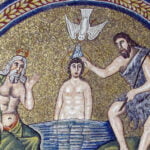In many films, writers and directors often include ‘Easter eggs’—allusions to earlier films which help to shape the plot and give depth and interest to the film.
In a similar way, Matthew’s quite brief account of Jesus’ baptism by John (the gospel reading for Epiphany 1 in Year A) includes a large number of allusions to the earlier story of God and Israel in the Old Testament. How might we spot these? What difference does it make to our understanding of the narrative? And how might this shape our reading and our preaching?
Join the conversation as James and Ian explore these issues as they work through the text.




























Some scholars believe that the purpose of Matthew’s Gospel was to present Jesus as the new Moses, an apologetic device to convince skeptical Jews of Jesus’ identity as their Messiah. So the question is: was Matthew using midrashes/allegories (fiction) for the purpose of converting skeptical Jews or was he presenting historical facts about Jesus?
Both and neither. ISTM he is organising his account of what actually happened to Jesus in ways that echo elements of the OT.
It is the sort of thing we do all the time in every day speech, and that preachers often use too.
‘I felt I was in the wilderness, facing trials and temptations’ is a perfectly good way of describing things that actually happened to me, but expressed in biblical language.
The truth is, no one can say for sure if the author of Matthew was recounting historical events or inventing stories for theological purposes. Scholars are not in agreement on the identity or eyewitness status of this anonymous author. But even if the author was using fictional material in his story about Jesus, that doesn’t necessarily mean that he was trying to deceive anyone. Greco-Roman biographies allowed for such embellishments. First century readers who knew Jesus would not have had a problem with these fictional elements. These details improve the story. They make for better reading. Let’s appreciate the beauty of these ancient tales without insisting them to be 100% historically accurate.
The question is a one of reliability of evidence. The is the test and reasons for law and rules of evidence in a court of law. In a civil court, the standard of proof, using reliable evidence, is on ” the balance of probabilities”, that is ” more likely than not”.
Additionally, as a matter of course opinion, even expert opinion, is not admissible.
Where does this idea of 100% come from. Is it from historians? Hardly. From medics? From physicians? From lawyers?
The answer is from a *straw man*, a fallacy.
A medical doctor in our church, joked; when there are 3 GP’s in a room, there you have 12 different opinions.
But then how do you know which parts are historically accurate and which arent? Do you use some of the nonsense criteria the Jesus Seminar used to decide? Do you conclude that the resurrection of Jesus didnt actually happen because ‘dead men dont rise’? And what sort of Jesus does such a view lead to – one made in our own image?
Peter
‘I felt I was in the wilderness, facing trials and temptations’ is a perfectly good way of describing things that actually happened to me, but expressed in biblical language.
It’s a good example of Heilsgeschichte – salvation history.
Sorry—I don’t understand what point you are making here. All I am showing is that you can use theological language to describe an actual event. Using this language doesn’t mean that the event wasn’t historical.
Where did I say that something was not historical?